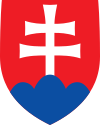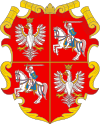
Back Portaal:Vlae en wapens Afrikaans بوابة:علم الشعارات Arabic Portal:Wappen German Portal:Heráldica y vexilología Spanish Portail:Héraldique French פורטל:דגלים וסמלים HE Portál:Heraldika Hungarian Portale:Araldica Italian Портал:Геральдика Kazakh Портал:Хералдика Macedonian
Welcome to the Heraldry and Vexillology Portal!


Heraldry encompasses all of the duties of a herald, including the science and art of designing, displaying, describing and recording coats of arms and badges, as well as the formal ceremonies and laws that regulate the use and inheritance of arms. The origins of heraldry lie in the medieval need to distinguish participants in battles or jousts, whose faces were hidden by steel helmets.
Vexillology (from the Latin vexillum, a flag or banner) is the scholarly study of flags, including the creation and development of a body of knowledge about flags of all types, their forms and functions, and of scientific theories and principles based on that knowledge. Flags were originally used to assist military coordination on the battlefield, and have evolved into a general tool for signalling and identification, particularly identification of countries.
Selected coat of arms

The coat of arms of Slovakia is composed of a silver (argent) double cross, elevated on the middle peak of a dark blue mountain consisting of three peaks. It is situated on a red (gules) early gothic shield. Extremities of the cross are amplificated, and its ends are concaved. The same symbol (with other colours and minor changes) is in the sinister portion of the Hungarian coat of arms. (more...)
Selected article

The tradition and practice of heraldry in Poland dates from the 13th century. Although influenced by French and German heraldic practice, differs in a number of respects. One of the most striking is that a coat of arms does not belong to a single family. Many, sometimes hundreds of unrelated families may use a single coat of arms. Each coat of arms also has its own name. One side-effect of this unique arrangement was that it became customary to refer to members of the nobility (Polish: Szlachta) by both their family name and the name of their coat of arms. (more...)
Selected flag

The National Flag of India was adopted in its present form during an ad hoc meeting of the Constituent Assembly held on the 22 July 1947, twenty-four days before India's independence from the British on 15 August 1947. It has served as the national flag of the Dominion of India between 15 August 1947 and 26 January 1950 and that of the Republic of India thereafter.
Designed by Pingali Venkayya, the flag is a horizontal tricolour of "deep saffron" at the top, white in the middle, and green at the bottom. In the centre, there is a navy blue wheel with twenty-four spokes, known as the Ashoka Chakra, taken from the Lion Capital of Asoka erected atop Ashoka pillar at Sarnath. The diameter of this Chakra is three-fourths of the height of the white strip. The ratio of the width of the flag to its length is 2:3. The official flag specifications require that the flag be made only of "khadi," a special type of hand-spun cloth made popular by Mahatma Gandhi. The display and use of the flag are strictly enforced by the Indian Flag Code. (more...)
Selected picture
Created in 1936, after the restoration of the monarchy, the Coat of arms of the Kingdom of Greece was used until 1967, when King Constantine II was exiled, and then nominally until 1973 when the kingdom was replaced by the Third Hellenic Republic. The arms remains in use by the former Greek Royal Family.
Did you know...
- ...that the pursuivant Thomas Hawley (pictured as King of Arms) was captured and detained before the Battle of Flodden, but released before the fighting started?
- ...that the herald Robert Glover was appointed to the office of Norroy King of Arms jointly with his 82-year-old father-in-law William Flower in 1580?
- ...that the coat of arms of Andalusia bears the Pillars of Hercules, the ancient name given to the promontories that flank the entrance to the Strait of Gibraltar?
- ...that the flag of New Mexico is designed after the Zia tribe's symbol?
- ...that Rideau was the first Canadian company to be granted its own coat of arms by the Canadian Heraldic Authority?
Related portals
|
|
|
Heraldry Web resources
Authorities
- Belgium - The Council of Nobility, Flemish Heraldic Council and Council of Heraldry and Vexillology of the French Community
- Canada - Canadian Heraldic Authority and see also Public Register of Arms, Flags and Badges
- England, Wales, and Northern Ireland - The College of Arms
- Ireland - The Office of the Chief Herald of Ireland
- Netherlands - High Council of Nobility
- Portugal - Instituto da Nobreza Portuguesa
- Scotland - The Court of the Lord Lyon
- South Africa - South African Bureau of Heraldry
- Sweden - National Board of Heraldry, The National Archive
- United States Army - The United States Army Institute of Heraldry
Societies
- Greek Heraldry Society
- The Academy of Heraldic Science Czech republic
- The American College of Heraldry
- The American Heraldry Society
- The Augustan Society
- The Australian Heraldry Society Inc.
- Bulgarian Heraldry and Vexillology Society
- The Center for Research of Orthodox Monarchism
- Cambridge University Heraldic and Genealogical Society
- Chiltern Heraldry Group
- The College of Dracology
- Croatian Heraldic and Vexillologic Association
- The Finnish Heraldic Society
- Fryske Rie foar Heraldyk
- Hellenic Armigers Society
- Guild of Heraldic Artists
- Genealogical Society of Ireland
- Heraldry Research Institute (Japan)
- The Heraldry Society
- The Heraldry Society of Africa
- The Heraldry Society of New Zealand Inc.
- The Heraldry Society of Scotland
- The Heraldry Society of Southern Africa
- The Institute of Heraldic and Genealogical Studies
- The International Association of Amateur Heralds
- Italian Center of Vexillological Studies
- Lancashire Heraldry Group
- Macedonian Heraldry Society
- New England Historic Genealogical Society Committee on Heraldry
- Norwegian Heraldry Society
- Oxford University Heraldry Society
- Polish Heraldry Society
- Polish Nobility Confederation
- Real Academia Matritense de Heráldica y Genealogía - Royal Academy of Heraldry and Genealogy of Madrid
- Romanian Institute for Genealogy and Heraldry
- The Royal Heraldry Society of Canada
- The Russian College of HeraldryThe Russian College of Heraldry
- Serbian Heraldic Society
- Societas Heraldica Scandinavica
- Societas Heraldica Slovenica
- Swedish Heraldic Society
- Ukrainian Heraldry Society
- Royal Association Genealogical and Heraldic Office of Belgium
Vexillology
Software
- Coat of Arms Visual Designer web-based program
- Puncher Heraldry Program
- Blazonry Server - pyBlazon
- DrawShield - creates SVG shield or arms image from blazon
- CoaMaker - web-based tool
- Blazon95 and BLAZONS! 2000, older Windows applications
- Heraldicon
Texts
- Heraldry, historical and popular : with seven hundred illustrations (1863)
- A Complete Guide to Heraldry (1909)
Other
Wikimedia
The following Wikimedia Foundation sister projects provide more on this subject:
-
Commons
Free media repository -
Wikibooks
Free textbooks and manuals -
Wikidata
Free knowledge base -
Wikinews
Free-content news -
Wikiquote
Collection of quotations -
Wikisource
Free-content library -
Wikispecies
Directory of species -
Wikiversity
Free learning tools -
Wikivoyage
Free travel guide -
Wiktionary
Dictionary and thesaurus
© MMXXIII Rich X Search. We shall prevail. All rights reserved. Rich X Search











